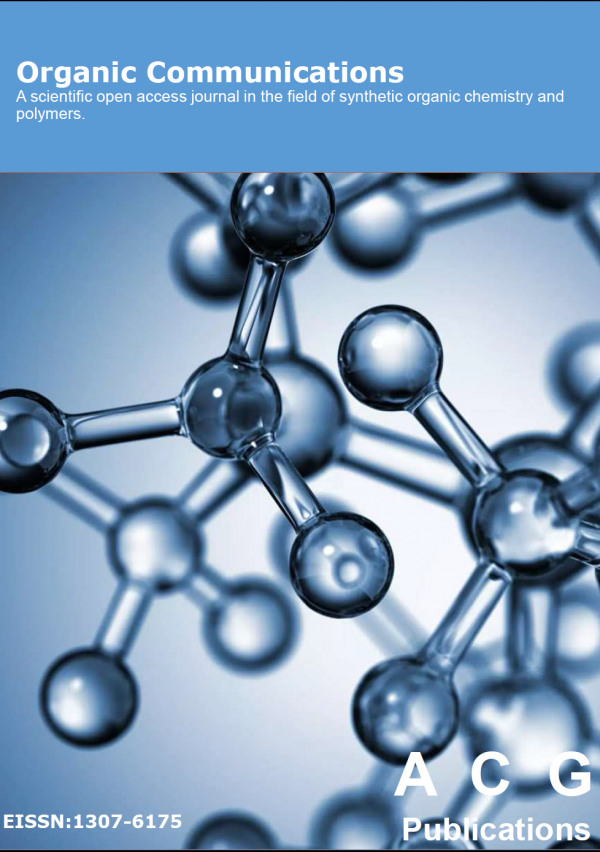Organic Communications
Year: 2018 Volume: 11 Issue:1 January-March
1) A review of the total synthesis of the most important marine natural products in the Red Sea
This review aims to comprehensively highlight the chemical syntheses of marine natural products isolated from organisms in the Red Sea. The synthetic approaches in the construction of complex molecules and their potent applications in drug design are summarised.
DOI http://doi.org/10.25135/acg.oc.37.18.01.064 Keywords Red Sea total synthesis marine natural products sterols DETAILS PDF OF ARTICLE © 2018 ACG Publications. All rights reserved.2) Triarylborane functionalized selenophenothiophene analogues: Syntheses, photophysical and electrochemical properties
Two novel acceptor–donor–acceptor (A–D–A) small molecules BSeT1 and BSeT2 containing dimesitylborane as an electron acceptor and selenopheno[3,2-b]thiophene and selenopheno[2,3-b]thiophene as electron donors linked through a thiophene p -conjugated spacer were synthesized and characterized. Their photophysical and electrochemical properties were investigated. In particular, BSeT1 demonstrated that the presence of a conjugated selenopheno[3,2-b]thiophene causes a bathochromic shift of the absorption bands with respect to a cross conjugated selenopheno[2,3-b]thiophene in BSeT2. The fluorescence spectra of BSeT1 exhibited yellow emission at 516 and 543 nm, while BSeT2 showed blue emission peak of 468 nm. Also, the emission quantum efficiency of BSeT1 was determined to be up to 11% in THF. These compounds demonstrated red-shift emissions in their solid states compared to those in organic solvents. The optimized geometries of BSeT1and BSeT2 were achieved by density functional theory (DFT) to examine their electronic structures, frontier molecular orbital (FMO) energy levels and electronic excitations. The comparisons illustrated that the theoretical data are well in alignment with the corresponding experimental results. In addition, the structure-property relationships of BSeT1 and BSeT2 were assessed.
DOI http://doi.org/10.25135/acg.oc.34.17.12.061 Keywords Selenophenothiophene triarylborane UV-Vis absorption spectroscopy fluorescence density functional theory (DFT) DETAILS PDF OF ARTICLE © 2018 ACG Publications. All rights reserved.3) Synthesis, theoretical calculation and α-glucosidase inhibition of new chalcone oximes
A series of eleven hydroxy and methoxy substituted new chalcone oximes (2a-2k) were synthesized by the condensation of chalcone (1a-1k) with hydroxylamine hydrochloride in pyridine. Structures of the synthesized compounds were characterized using NMR (1D; 1H, 13C/APT and 2D 1H- 1H COSY, NOESY and ROESY), FT-IR, UV, LC-MS/MS spectral data and elemental analysis. These synthetic compounds (2a-k) were screened for their α-glucosidase inhibition. The most α-glucosidase inhibitory activity were observe on compounds 2a and 2b with in the range of 1.61-3.36 µM (IC 50 values) which were more active then acarbose (IC 50, 13,34 µM). IC 50 values of other synthesized compounds 2c-2h are within the range of 7,25-25,55 µM which were more or as active as acarbose, but, IC 50 values for compounds 2j-2k were not observed. The geometric isomers of compounds 2a-2k were calculated theoretically. Experimental and theoretical calculations showed that cisoid 1E,2E is the most stable geometrical isomer of all.
DOI http://doi.org/10.25135/acg.oc.38.18.02.067 Keywords Chalcone chalcone oxime α-glucosidase inhibition DETAILS PDF OF ARTICLE © 2018 ACG Publications. All rights reserved.4) Nucleoside substituted perhydro-1λ5-[1,3,2]diazaphospholo[1,5-a]pyridine-1-thione analogues: Synthesis and evaluation of antiviral and antimicrobial activities
A new series of nucleoside substituted perhydro-1λ 5-[1,3,2]diazaphospholo[1,5-a]pyridine-3-thione derivatives 4(a-j) was synthesized by a one-pot two-step process. It involves the formation of key intermediate, 1-chloroperhydro-1λ 5-[1,3,2]diazaphospholo [1,5-a]pyridine-1-thione (3) and its subsequent reaction with various nucleosides to obtain the title products 4(a-j). Structures of all the newly synthesized compounds were elucidated by spectral analysis. Compound (4b)linked with zidovudine exhibited highest antiviral and antimicrobial activities as compared to other nucleoside derivatives.
DOI http://doi.org/10.25135/acg.oc.35.17.12.055 Keywords 2(±)-Aminomethyl piperidine thiophosphoryl chloride nucleosides antiviral activity antimicrobial activity DETAILS PDF OF ARTICLE © 2018 ACG Publications. All rights reserved.5) Cycloaddition reactions of silacyclopropylidenoids to ethylene
The cycloaddition reactions of silacyclopropylidenoids (C 2H 4SiXLi, X = F, Cl, Br) to ethylene have been investigated separately to gain insights into halogen and solvation effects on the energetic of the proposed reactions at the B3LYP/6–311+G(d,p) level of theory. The calculations reveal that the addition of silacyclopropylidenoids to ethylene occurs via stepwise mechanisms. The required initial energy barriers for the conversion of silacyclopropylidenoids to silaspiropentanes are determined to be ΔG = 77.4 kJ/mol, 9.6 kJ/mol, and 9.2 kJ/mol for F, Cl, and Br, respectively. Furthermore, the gas phase calculations show that the reactions are not spontaneous at room temperature, whereas those of THF solvated models indicate that the formations of silaspiropentanes are spontaneous in the cases of X = Br and Cl. Additionally, the findings show that the silacyclopropylidene addition to ethylene is determined to be exergonic in both gas and THF phases by ΔG = –42.6 kJ/mol and –39.3 kJ/mol, respectively.
DOI http://doi.org/10.25135/acg.oc.36.17.07.043 Keywords Silacyclopropylidenoids silylenoid silaspiropentane reaction mechanism DFT DETAILS PDF OF ARTICLE © 2018 ACG Publications. All rights reserved.6) Synthesis of natural phenylpropanoid esters via conventional chemical reactions
Using classical reactions, the synthesis of seven natural esters was described, including for the first time the synthesis of four natural phenylpropanoid esters — compounds that have demonstrated promising bioactivity, proven by preliminary studies using samples obtained from natural sources. Applying the Wittig reaction, cis- and trans-bornyl ferulates were obtained, in an unusual manner, which established an alternative for the preparation of phenylpropanoid esters, especially in the synthesis of phenolic esters of tertiary alcohols such as the α- terpinyl trans-caffeate. The compounds obtained were identified and characterized by 1H-NMR and 13C-NMR spectroscopy.
DOI http://doi.org/10.25135/acg.oc.39.18.02.065 Keywords Wittig reaction esterification phenylpropanoid esters DETAILS PDF OF ARTICLE © 2018 ACG Publications. All rights reserved.7) A simplified synthetic route and study of anticancer activity of Ethyl 2-(4-fluorophenyl)-5-hydroxy-6- nitrobenzofuran-3-carboxylate and its methyl derivative
Preparation of a biologically active benzofuran derivative ethyl 2-(4-fluorophenyl)-5-hydroxy-6-nitro - benzofuran-3-carboxylate from commercially available starting materials 2- bromo-4-methoxy-phenol and para- fluorophenylacetylene is described in four steps with good yields. The final compound and all the intermediates reported in the method were characterized by spectroscopic techniques. Finally, the target molecule and its methyl derivative were tested for their anticancer activity and were found to be 95.2 μg/mL and 8.5 μg/mL (IC 50) respectively against HCT 116 cell line.
DOI http://doi.org/10.25135/acg.oc.40.18.02.066 Keywords Cytotoxicity HCT116 ethyl 2-(4-fluorophenyl)-5-hydroxy-6- nitrobenzofuran-3- carboxylate 2-bromo-4-methoxy-phenol MTT DETAILS PDF OF ARTICLE © 2018 ACG Publications. All rights reserved.